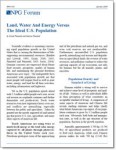Land, Water and Energy Versus the Ideal U.S. Population
- David Pimentel and Marcia Pimentel
- January 19, 2005
- Forum Papers
- Forum Paper
- 0 Comments
Click here for a downloadable, printable PDF version

Scientific evidence is mounting concerning rapid population growth in the United States that is causing the deterioration of life supporting environmental resources (Bartlett and Lytwak, 1995; Grant, 2000, 2003; Pimentel and Pimentel, 2003; Sachs, 2004). Genuine concerns are expressed about future food security, prosperity, quality of human life, and maintaining the personal freedoms Americans now enjoy. The indisputable facts associated with population growth are that more people will require food as well as pure water, energy, and land for all their activities, including urbanization and highways.
Yet as the U.S. population speeds ahead with 3.3 million added people each year, severe soil erosion on croplands continues and further diminishes soil productivity. Fresh water resources even now experience heavy over-use, and conflicts are intensifying, especially between the public and agriculture. Taken for granted are the mostly imported oil and natural gas that power U.S. cars, agriculture, and many other aspects of American life.
David Pimentel is a professor in the College of Agriculture and Life Sciences at Cornell University. He has published extensively and has chaired panels dealing with food, energy, population and natural resources, for the National Academy of Sciences, the American Association for the Advancement of Science and the U.S. Department of Energy.
Marcia Pimentel is Senior Lecturer (retired), Division of Nutritional Sciences in the College of Human Ecology at Cornell. She has authored a book and several papers dealing with nutrition and human populations.
